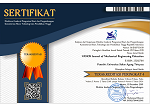Critical Thinking Skills through Industrial Revolution 4.0 for Vocational Education
Abstract
ABSTRACT
Research is presented to map State Vocational High School (SMKN) in Boyolali based on Higher Order Thinking Skills (HOTS) owned by students. HOTS is indispensable in facing critical thinking skills in the 21st century. The research used uses a qualitative type of survey approach. Students in vocational schools are given cognitive questions oriented to HOTS which refers to Bloom's taxonomy, in the form of evaluating, analyzing, and creating. Questions are presented in multiple choice forms and have been validated with the questmaster program. The results showed that HOTS owned by students in Boyolali Vocational High School was still relatively low, ie 36% at SMKN 1 Klego, 37% in SMKN Nogosari, and 41% in students at SMKN 1 Klego.
Keywords
Full Text:
PDFReferences
Anderson, L. W. & Krathwohl, D. R. (2001). A taxonomy for learning, teaching, and assessing: A revision of Bloom’s taxonomy of educational objectives. Ney York: Addison Wesley Longman.
Arwood , E. L . (2011). Language Function an Introduction to Pragmatic Assessment and Intervention for Higher Order Thinking and Batter Literacy. Philadelphia: Jessica Kingsley Publishers.
Badan Pusat Statistik (BPS). (2020). Statistical Yearbook of Indonesia 2020. Jakarta: Badan Pusat Statistik
Bloom, B.S, et al. (1956). Taxonomy of Educational Objectives: Handbook 1, Cognitive Domain. New York: David McKay.
Hashim, R. (2003). Malaysian teachers’ attitudes, competency and practices in the teaching of thinking. Intellectual Discourse, 11(1). 27-50. Retrieved from http://lib.iium.edu.my/mom2/cm/content/view/view.jsp?key=xrBk7W4u6qV1nyWvPH9MD2yjypXpJ0lg200912 29144553937
Hermann, M., Pentek, T., & Otto, B. (2016). Design Principles for Industrie 4.0 Scenarios. Presented at the 49th Hawaiian International Conference on Systems Science.
Hidayanti, D., et al. (2016). Analisis Kemampuan Berpikir Kritis Siswa SMP Kelas IX pada Materi Kesebagunan. Konferensi Nasional Penelitian Matematika dan Pembelajarannya Universitas Muhammadiyah Surakarta.
International Labour Organization. (2020). World Employment and Social Outlook – Trends 2020. Geneva: International Labour Office.
Irianto, D. (2017). Industry 4.0; The Challenges of Tomorrow. Presented at the National Seminar on Industrial Engineering, Batu-Malang.
Kempirmase, F., Carolina Selfisina, A., Darma Andreas, N. (2019). Kemampuan Berpikir kritis Siswa dalam Menyelesaikan Soal-soal Higher Order Thinking School (HOTS) pada Materi Barisan dan Deret Aritmatika di Kelas XI SMA Negeri 10 Ambon. Prosiding Seminar Nasional Pendidikan Matematika Universitas Pattimura.
Nachiappan, S., Damahuri, A. A., Ganaprakasam, C., & Suffian, S. (2018). Application of Higher Order Thinking Skills (Hots) In Teaching And Learning Through Communication Component And Spiritual, Attitudes And Values Component In Preschool. International Journal of Early Childhood Education Care vol 7.
Rooney, Caitriona. (2012). How am I Using Inquiry-BasedvLearning to Improve My Practice and to Encourage Higher Order Thinking Among My Students of Mathematics. Educational Journal.
Trilling, B & Fadel, C. (2009). 21st-century skills: learning for life in our times. US: Jossey-Bass A Wiley Imprint.
Yahya, M. (2018). Industrial Era 4.0: Challenges and Opportunities for the Development of Indonesian Vocational Education. Inauguration Speech for Permanent Professor in the Field of Vocational Education Science, Faculty of Engineering, Makassar State University.
Zohar, A., Degani, A., & Vaaknin, E. (2001). Teachers’ beliefs about low-achieving students and higher order thinking. Teaching and Teacher Education, 17, 469-485. Retrieved from http://academic.sun.ac.za/mathed/174/TeachersLowAchievers.pdf
DOI: http://dx.doi.org/10.30870/vanos.v5i2.8784
Refbacks
- There are currently no refbacks.

This work is licensed under a Creative Commons Attribution 4.0 International License.


.png)
.png)
